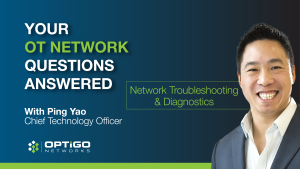The Growing Challenge of OT Network Data Integrity
With the exponential growth of OT network data*, ensuring that all information remains accurate, consistent, and validated can be overwhelming. Data integrity is crucial for organizations to maintain reliable operations, comply with industry regulations, and make informed decisions based on trustworthy data.
In our first article on the importance of data integrity, we looked at how the overall reliability of your network comes down to how reliable your data is. In this article, let’s follow that up by exploring five tactics for maintaining OT network data integrity—but first, let’s clarify a few key concepts.
Don’t Confuse the Data: Integrity vs. Quality, Physical vs. Logical
Data Quality vs. Data Integrity
- Data Quality: The dependability and accuracy of data. High-quality data is accurate, reliable, complete, unique, and timely.
- Data Integrity: Encompasses both data quality and security. It ensures data is retained properly, destroyed when necessary, and complies with industry and government regulations.
Two Main Types of Data Integrity
- Physical Data Integrity: Protects data from hardware or storage failures. This includes implementing backups, fault-tolerant systems, and disaster recovery plans to safeguard against technical failures.
- Logical Data Integrity: Ensures that data remains unaltered as it moves between systems, applications, or databases. This includes validation rules that prevent incorrect data entry and access controls that restrict unauthorized modifications.
Five Best Practices to Ensure OT Network Data Integrity
1. Validate Your Data
Implement validation checks to ensure data consistency during transfer. For example, the checksum errors diagnostic in OptigoVN is a common method we use to detect corruption in BACnet data.
As mentioned above, follow the Five Pillars of Data Quality:
- Accuracy: Ensure data is correct and free of errors.
- Completeness: Confirm that all necessary data is present.
- Consistency: Maintain uniform data across different systems.
- Reliability: Ensure data remains accurate over time.
- Timeliness: Keep data up to date for real-time decision-making.
2. Implement Access Control
Long gone are the days of having just one admin account or one shared login for automation systems. Restricting unauthorized access to OT networks is essential to maintaining integrity and preventing security issues. Implementing Role-Based Access Control (RBAC) ensures that only authorized personnel—in facilities or IT—have access to sensitive data based on their job functions.
Organizations should enforce the principle of least privilege (PoLP) by limiting access rights to only what is necessary for users to perform their tasks. Multi-factor authentication (MFA) adds an additional security layer, making it more difficult for attackers to gain unauthorized access.
Finally, regular access reviews should be conducted to identify and remove unnecessary permissions, reducing the risk of insider threats or accidental data corruption. This kind of regular housekeeping should be coordinated with anyone who has access: OT networking, IT pros, and any outside system integrators or vendors.
3. Follow Cybersecurity Best Practices
While BACnet data itself isn’t encrypted (unless using BACnet SC), networks should be segmented and firewalled from the larger IT infrastructure to prevent unauthorized access. Implementing VLANs, secure BBMD configurations, and monitoring for unauthorized devices can help safeguard data integrity.
And don’t forget to include your friends! Your security posture becomes more secure when all your partners and vendors are part of the plan. For more details, check out our guide to collaborative crisis response.
4. Maintain Backups
World Backup Day exists for a reason! Regularly back up your device configurations and critical data. Automated, centralized backups ensure that if a failure occurs, critical information can be restored without data loss or corruption.
5. Conduct Regular Audits
Review and verify data on a routine basis to ensure its accuracy, completeness, and consistency. Log audits help identify discrepancies and allow teams to address potential data integrity issues proactively.
How OptigoVN Helps Maintain Data Integrity in OT Networks
OptigoVN helps organizations ensure data integrity by providing continuous visibility, proactive monitoring, and diagnostic tools that keep network traffic reliable and secure. Here’s how:
1. Minimizing Packet Loss and Latency
Data integrity relies on accurate, uncorrupted data reaching its destination. OptigoVN’s diagnostics look at over 28 different aspects of traffic and device health, including packet loss, high latency, and retransmissions, helping operators identify and resolve network bottlenecks, addressing, or device failure that could compromise data quality.
2. Detecting and Preventing Anomalous Traffic
Unexpected network traffic spikes or unauthorized device communications can indicate data manipulation or misconfigurations. OptigoVN continuously monitors BACnet traffic, flagging results outside recommended ranges before they impact operations.
3. Identifying and Resolving Addressing Conflicts
Duplicate IP addresses, misconfigured BACnet Broadcast Management Devices (BBMDs), or excessive Who-Is/I-Am traffic can cause data mismatches across systems. OptigoVN pinpoints and helps resolve these conflicts, ensuring that devices receive and send the correct information.
4. Tracking Device Health and Connectivity
If a sensor or controller goes offline, data streams can become incomplete or unreliable. OptigoVN provides a real-time device inventory, helping teams address connectivity issues before they result in missing or corrupted data.
5. Enabling Proactive Root Cause Analysis
Rather than waiting for bad data to surface in analytics or dashboards, or worse—in real world environments—OptigoVN helps teams perform real-time diagnostics on network conditions. This allows users to catch potential data integrity risks at the network level before they affect decision-making.
Bonus: A Healthy OT Network Checklist for IT Pros!
Today, it’s not uncommon to see facility managers and systems integrators coordinate with IT teams and managed service providers. For IT managers, this might mean redefining the scope and definition of a healthy network to one that extends beyond the “traditional IT” scope of IP switches, VLANs, and routers to include unique devices like MS/TP controllers, BBMDs, and BACnet gateways.
So if you’re an IT pro new to working with BACnet, we’ve put together this guide filled with things to consider when monitoring, managing, and maintaining BACnet network health.
Ensuring data integrity in OT networks isn’t just about avoiding errors—it’s about maintaining the reliability and security of the entire system. By following best practices like validation, access control, security segmentation, regular backups, and audits, organizations can protect their data from corruption and unauthorized modifications.
With OptigoVN, OT network monitoring and troubleshooting just got easier. To find out for yourself, click here to request a demo, or create your free account and start exploring today.
*Fun Fact: In 2024, Optigo Networks helped 1300+ companies upload and process over 2500 packet captures of BACnet data—nearly 15 terabytes—from OT networks alone!
FAQ: Ensuring Data Integrity in OT Networks
Q1: What is data integrity in OT networks?
Data integrity in OT networks means keeping your operational data accurate, consistent, and secure throughout its lifecycle, ensuring reliable operations and compliance.
Q2: How is data integrity different from data quality?
Data quality refers to how accurate and complete your data is, while data integrity includes quality plus security measures to protect data from unauthorized changes or loss.
Q3: What are the main types of data integrity in OT networks?
There are two types: physical integrity, which protects against hardware or storage failures, and logical integrity, which ensures data is correct and unaltered during transmission and processing.
Q4: How can I validate data to maintain integrity in my OT network?
Use validation checks like checksums and diagnostics tools (e.g., OptigoVN’s checksum error detection) to verify data consistency and catch corruption early.
Q5: Why is access control important for OT network data integrity?
Restricting access with Role-Based Access Control (RBAC) and multi-factor authentication prevents unauthorized users from changing or corrupting data.
Q6: What cybersecurity practices support data integrity in OT environments?
Segmenting networks, configuring firewalls, using VLANs, and monitoring for unauthorized devices all help protect data from tampering or loss.
Q7: How often should I back up OT network data?
Regular, automated backups are critical to restore data after failures, minimizing the risk of data loss or corruption.
Q8: What role do audits play in maintaining OT data integrity?
Regular audits review and verify data accuracy and completeness, allowing you to detect and fix issues before they impact operations.
Q9: How does Optigo Visual Networks help maintain OT network data integrity?
OptigoVN offers continuous monitoring, diagnostics, and visibility into traffic and device health, helping you detect issues like packet loss, traffic anomalies, and device conflicts that threaten data integrity.
FAQs are created with the assistance of generative AI





